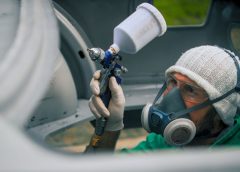Painting your car is exciting, especially when your goal is to give your vehicle a new look with a fresh coat of paint. However, the painting process is not always as easy as it seems.
There are many potential issues you may encounter as you move through the painting process. Explore four common problems you may face when painting your car and learn how you can tackle them head-on to achieve the perfect finish for your vehicle.
Poor Paint Adhesion
One of the most frustrating car-painting problems is when the paint does not adhere well to the vehicle’s surface. Poor paint adhesion often results in visible flaking or peeling, giving your car an unappealing look. Some of the reasons why paint may not adhere well include:
- Not removing all the old paint or rust before painting
- Not cleaning the surface properly
- Choosing the wrong type of paint for your car
To prevent this problem, sand and clean the area properly to remove any dirt or old paint. You can also consult a professional to help you choose the right type of paint for your vehicle.
Uneven Paint Job
Another common problem when painting your car is applying paint unevenly, resulting in painted spots that are thicker in some areas and thinner in others—this is sometimes known as “orange peel.” This issue can be caused by incorrect spray technique, too much paint applied in one area, or painting in high humidity or low temperatures.
The best way to avoid this problem is by using proper spraying techniques, applying thin layers of paint following the manufacturer’s instructions, and painting in optimal temperature conditions.
Dust and Dirt Inclusions
Dirt and dust can quickly ruin a paint job. Debris can make the finish look dull, dirty, and unattractive. Inclusions often occur when paint is applied in an unclean space, in an area with high traffic, or in an area with a lot of dust or debris.
To prevent these issues, paint in a controlled environment, such as a paint booth, and ensure the area is clean and free of dust and debris before beginning. Cover your car with plastic if you’re painting outside to protect it from dust and debris.
Fisheye and Bubbling
Fisheye and bubbling can also occur when painting a car. Fisheye is the appearance of small, crater-like depressions in your paint finish caused by contaminants such as wax or silicone on the surface. Bubbling occurs when air gets trapped beneath the paint film, resulting in raised bumps instead of a smooth finish.
Knowing how to fix fisheye and bubbling paint can help you avoid costly mistakes down the line. Ultimately, the key to preventing these problems is proper surface preparation and quality paint products.
Painting your car can be a fun and rewarding experience, but the process is challenging. Common problems that may arise when painting your car include poor paint adhesion, an uneven paint job, dust and dirt inclusions, and runs or bubbling. However, you can overcome these challenges and achieve a professional-looking finish by following the tips mentioned above. In the end, your car will look as good as new, and you will be satisfied knowing that you did the work yourself.





